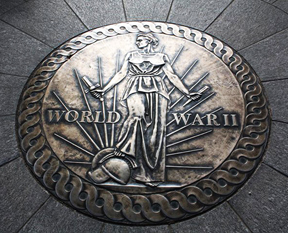
NPS

Library of Congress LC-USZ62-104778
On December 7, 1941 the Japanese Imperial Navy’s attack on Pearl Harbor virtually destroyed the United States’ Pacific fleet, and jolted the United States into the Second World War. The surprise attack shocked a generation of Americans, sowing fear and anger. On December 8, President Franklin Delano Roosevelt asked Congress for a declaration of war in an unforgettable speech. Both of these events that defined a generation of Americans are recalled in the World War II Memorial in Washington, D.C. through quotations and imagery.

NPS
A portion of FDR’s December 8 speech is engraved along the Pacific side of the memorial, capturing the reaction to the attack on Pearl Harbor: “December 7, 1941, a date which will live in infamy… No matter how long it may take us to overcome this premeditated invasion, the American people, in their righteous might, will win through to absolute victory.” Roosevelt’s statement received resounding applause, and men rushed to enlist to help in the war effort.
The classical image of an American family learning of the events on that fateful day is captured in a bas relief (top). Each member of the family has stopped to listen intently to the radio. The image symbolizes this unforgettable, life-changing moment for the WWII generation. Pearl Harbor still resonates with this particular generation, the name stirring thoughts and emotions.

NPS
The WWII Memorial serves to remind all of us of the events of the war, but more importantly it honors the people who served. The events at Pearl Harbor are at the root of both stories. It was the beginning of a long and bloody war, but it was also an awakening for a generation of Americans who answered the call of duty, and won through “to absolute victory.”
Last updated: June 3, 2016
